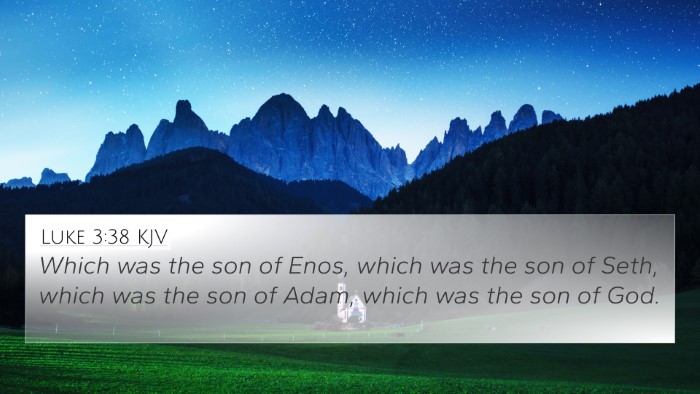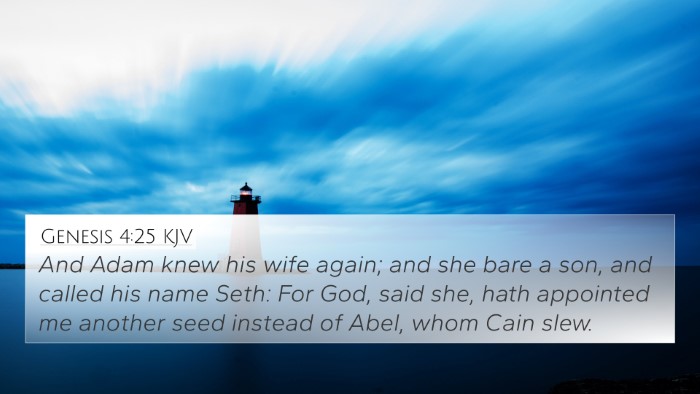Understanding 1 Chronicles 1:1
1 Chronicles 1:1 states: "Adam, Seth, Enosh." This verse begins the genealogical record of the Israelites, illustrating their lineage from Adam through to the nation of Israel. The significance of this verse extends beyond mere lineage; it is foundational for understanding God's covenant with humanity.
Summary of Insights from Public Domain Commentaries
This section summarizes thoughts from notable commentators like Matthew Henry, Albert Barnes, and Adam Clarke, providing a comprehensive view of the verse's meaning.
Genealogical Significance
- Matthew Henry: He emphasizes that the genealogy listed in this verse is not just a historical account but serves a theological purpose. It connects humanity to God’s redemptive plan, highlighting the importance of family and heritage in biblical context.
- Albert Barnes: Barnes notes that naming Adam in this verse sets the stage for the understanding of human beginnings and the fall, which is crucial for appreciating the entirety of the biblical narrative concerning sin and redemption.
- Adam Clarke: Clarke remarks on the simplicity of the names given but stresses their importance as the progenitors of the human race, allowing readers to trace the lineage that leads to significant biblical figures.
Theological Implications
This verse encapsulates the doctrine of original sin and the need for salvation, underscoring the descent from Adam to all humanity.
Inter-Biblical Dialogue and Connections
The verse invites reflection on several connecting threads throughout scripture. Here are some significant Bible cross-references related to 1 Chronicles 1:1:
- Genesis 1:26-27: Creation of humanity in God's image, connecting Adam's creation to the nature of humankind.
- Romans 5:12: The entrance of sin into the world through one man, Adam, establishing the theological foundation for sin's impact on humanity.
- Luke 3:38: Tracing Jesus’ genealogy back to Adam, reinforcing the significance of this verse in the Messianic lineage.
- 1 Corinthians 15:22: Discussing Adam and Christ, showing the contrast between Adam as a source of death and Christ as a source of life.
- Acts 17:26: Paul’s declaration that God made every nation from one man, affirming the universal roots in Adam.
- Ephesians 2:13-19: Discussing unity among believers, highlighting how all descendants of Adam come together in Christ.
- Hebrews 7:14: References to Judah, demonstrating the lineage leading to Jesus through family connections.
Thematic Bible Verse Connections
The genealogy initiates thematic explorations found in various Bible verses that relate to legacy, sin, redemption, and salvation. Here are some angles:
- Legacy and Heritage: The idea that each generation carries forward the traits and stories of their ancestors is a recurring theme.
- Sin and Redemption: Understanding Adam's fall allows believers to grasp the significance of Christ's redemptive work as a corrective to Adam's legacy.
Comparative Bible Verse Analysis
When performing a comparative analysis, consider how this verse interplays with others discussing humanity's origin and God’s overarching narrative of salvation. Use these tools for Bible cross-referencing to enhance study:
- Bible concordance to find related verses.
- Bible cross-reference guide for deeper insights.
- Bible reference resources for thorough examinations.
How to Utilize Cross-References
For studying connections between Bible verses effectively, consider the following:
- Identify key themes that appear across scripture.
- Utilize reference materials that provide context and background for each verse.
- Engage in cross-referencing Bible study methods to enhance understanding.
Conclusion
1 Chronicles 1:1 is not merely a record of ancestry; it sets the foundation for the biblical story of redemption. Understanding this verse through cross-referencing helps in grasping the broader covenantal themes and the link between Adam and Christ.




